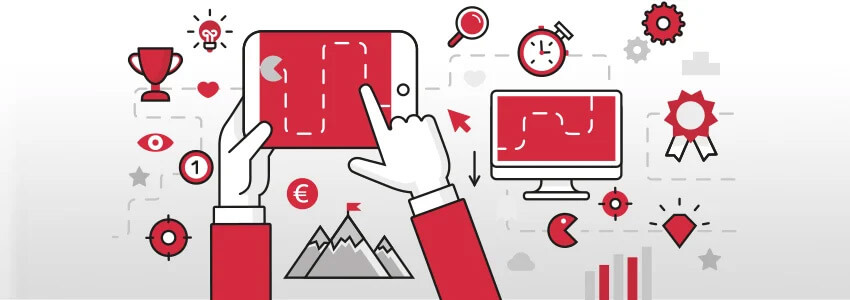Leads are essential for every B2B company. But what happens when they don't come? Since many of our customers struggle with exactly this challenge, we know the problem all too well.
The ability to consistently generate high-quality leads is critical to survival and growth in a competitive market environment.
In this article, we'll not only look at why lead generation is so important for B2B companies, but also how it has changed over time. We'll introduce different types of leads and explain the best practices companies can use to effectively increase their lead generation. From optimizing webinars and landing pages to identifying the right target audience and automating processes, we'll cover all the essential aspects you need to know to optimize your lead generation and thus achieve your business goals.
Why Should B2B Companies Prioritize Lead Generation?

Qualified lead generation is important for B2B marketing. In markets with lengthy decision-making processes, a consistent flow of quality leads supports business growth. Effective lead generation helps companies work towards their sales and growth objectives.
A systematic approach to lead generation allows companies to expand their customer base strategically. By focusing on potentially valuable long-term prospects, businesses can improve sales efficiency and optimize marketing returns.
Successful lead generation also provides insights into target audience preferences and behaviors, which can inform product and service improvements. In competitive markets, a robust lead generation strategy can help a company differentiate itself.
Effective lead generation is both a short-term tactic and a long-term investment in company stability and growth. It provides a foundation for adapting to market changes and working towards business goals.
Lead Generation in the Digital Age
The methods for generating leads have changed considerably. In the past, companies relied on time-consuming cold calling or expensive exhibition stands. Today, companies reach potential customers during the research phase. Many interested parties now find out more about products online before making a purchase decision.
Companies that address prospects' specific problems and questions early on establish themselves as experts and increase their chances of being preferred. According to Forrester Research, 74% of B2B buyers conduct more than half of their research online before making a sales contact. Furthermore, a study by Google found that B2B buyers conduct an average of twelve searches before visiting a brand on their website.
DIFFERENT TYPES OF LEADS
In the world of B2B marketing, we fundamentally distinguish between different lead types, each of which requires a specific approach to lead nurturing. Cold and warm leads in particular play a central role in the sales cycle.
Cold leads
Cold leads are individuals or companies who have shown an initial, superficial interest in your product or service. They are not yet ready to make a purchasing decision and require more information and persuasion to move further down the sales funnel.
- Example 1 : A website visitor fills out a contact form to subscribe to a general newsletter without making any specific requests.
- Example 2 : A prospect downloads a general information guide but does not participate in further marketing activities.
Warm leads
Warm leads have already demonstrated a deeper level of interest and a higher level of willingness to buy. They have gone beyond simply gathering information and have taken specific actions that signal a potential willingness to buy.
- Example 1 : A lead signed up for a webinar that focused on specific challenges in your industry and asked for more details about your products after the webinar.
- Example 2 : A visitor to your website uses the contact form to request a demo of a product, indicating that there is genuine interest in purchasing.
Understanding these differences and targeting leads based on their status can significantly improve the efficiency of the sales process and increase conversion rates. Effective lead management requires an adapted communication strategy aimed at warming up cold leads and closing warm leads.
DIFFERENTIATING BETWEEN MQLS AND SQLS IN LEAD GENERATION

In B2B marketing, it's crucial to distinguish Marketing Qualified Leads (MQLs) from Sales Qualified Leads (SQLs). MQLs are contacts who have shown interest, such as by downloading content or attending webinars. They require targeted marketing actions to increase their willingness to buy.
SQLs, on the other hand, are leads that have sent buying signals, such as requesting a quote. They are ready for direct sales approaches. Effectively segmenting and specifically treating MQLs and SQLs improves resource utilization and conversion rates by ensuring each lead receives the appropriate attention.
Effective Lead Generation Strategies from W4
1. Webinars
At W4, we actively use webinars to demonstrate our expertise in specialized marketing areas and share valuable information. These online events prove to be an effective means of lead generation. Targeted promotion on platforms such as LinkedIn reaches a relevant audience and provides ideal opportunities to connect directly with potential customers.
Registration for webinars takes place via specially developed landing pages on which participants leave important contact details such as their email addresses. This information is crucial for effectively providing participants with targeted information and offers even after the webinar. In this way, interest is efficiently converted into qualified leads and the customer base is continuously strengthened.
2. Landing Pages

Landing pages are a crucial tool in our lead generation strategy at W4. These specially designed web pages aim to generate leads by focusing on specific topics or offers. Once set up, they allow you to address your target audience directly and effectively.
The design of each landing page offers clear added value - whether through free information material, exclusive e-books or the opportunity to arrange a personal consultation. These offers are strategically designed to motivate interested parties to leave their contact details. When designing the forms for data entry, special attention is paid to ensuring that they are quick and easy to fill out and immediately catch the eye in order to optimize the lead generation process for users and increase conversion rates.
3. Target group Identification
Precise target group identification is essential to effectively increase lead generation. By creating marketing personas based on a combination of qualitative and quantitative data analysis, companies can gain deep insights into the specific needs and behaviors of their potential customers. These personas help tailor marketing strategies precisely to the interests and challenges of the target group.
By specifically targeting the identified personas with tailored campaigns, the likelihood of generating high-quality leads increases. This not only leads to a better conversion rate, but also to a more efficient use of marketing resources. Companies that know and understand their personas precisely are able to place their messages optimally and thus effectively convert the interest of their target group into leads.
4. Lead generation automation
Automating lead generation enables companies to work more efficiently and purposefully. By using automated systems, processes such as lead capture, email marketing, maintaining contacts ( lead nurturing ) and evaluating leads according to their potential ( lead scoring ) can be made much more efficient.
A practical example of automation is the use of online forms and personalized email campaigns that are automatically triggered as soon as a prospect performs certain actions on the website. Likewise, chatbots can be used to immediately answer visitors' queries and collect qualified information that flows directly into the company's database.
In this context, we use HubSpot, a leading tool in the automation of marketing processes. As a HubSpot diamondpla partner, we have gained extensive experience that enables us not only to optimize our own processes, but also to help other companies to effectively automate their lead generation. HubSpot offers an integrated platform that seamlessly connects many aspects of lead generation, thus leading to an increased conversion rate and better performance of marketing campaigns.
5. Email Marketing
Email marketing plays a central role in our digital communication strategy. Over the years, we have identified three key aspects that have significantly improved our email marketing results:
- Hyper-personalized trigger emails : Using advanced segmentation allows you to send trigger emails that respond to specific user behaviors. For example, a personalized email can be sent automatically when a user spends a long time on an important product page. Such targeted emails increase relevance for the user and improve the chances of conversion.
- Test email designs with A/B split heatmaps : To increase email effectiveness, it's helpful to not only run traditional A/B tests but also use heatmaps to show where users click and how they navigate within the email. These insights are valuable for optimizing design and call-to-action placement.
- Email gamification : Incorporating gamification elements into emails, such as interactive puzzles or mini-games that unlock special offers or discounts, can increase engagement and deepen interaction with the content. This tactic has been proven effective in increasing user engagement.
6. Offer sufficient contact options

Providing multiple ways to contact you is crucial for lead generation. Studies show that companies that offer multiple communication channels have a 50% higher engagement rate with prospects. It's important that prospects can get in touch with your company in their preferred way, whether that's through traditional channels like phone and email or modern platforms like social media and live chat.
By ensuring your contact paths are clearly communicated, easily accessible and efficiently managed, you can increase user satisfaction and increase the likelihood of successful conversion.
7. Search engine optimization
Search engine optimization (SEO) is a critical factor in digital success and lead generation. Statistics from UpLead show that conversions from organic search have an impressive completion rate of 14.6% . This high effectiveness underscores the importance of a well-thought-out SEO strategy aimed at increasing visibility in search results and driving high-quality traffic to your website.
By optimizing their web content for SEO, companies can improve the reach of their offers and thus reach more potential customers. Continuous adaptation and monitoring of SEO measures are essential in order to be successful in the constantly changing market environment and to maximize conversion rates.
8. Content Marketing
The importance of content marketing for lead generation cannot be underestimated. According to a study by DemandSage, 67% of B2B companies that blog regularly generate more leads than those that do not . This shows the importance of stimulating the interest of potential customers through high-quality content.
By providing relevant and informative articles, companies can not only demonstrate their expertise but also build trust with the target audience. A well-thought-out content marketing program that specifically addresses the needs and questions of the target audience not only improves lead generation but also promotes customer retention and strengthens brand loyalty.
9. Sales Funnel Optimization
Sales funnel optimization is critical to maximizing the effectiveness of marketing and sales strategies. A well-structured sales funnel allows companies to monitor and improve the entire customer acquisition process, from initial contact to purchase completion.
By analyzing each stage of the funnel in a targeted manner, weak points can be identified and optimized, leading to a higher conversion rate. Measures such as refining landing pages, adjusting call-to-actions and improving follow-up emails are essential. Companies that continuously analyze and adjust their sales funnel can ensure that no potential leads are lost and that every step in the funnel is geared toward guiding the customer further and ultimately encouraging them to make a purchase.
This continuous optimization not only ensures more efficient marketing activities, but also increases customer trust by providing them with a seamless and engaging shopping process.
10. Social media
Social media is an essential tool for modern lead generation. Especially in the B2B area of lead generation, we are a big advocate of LinkedIn. As a platform specifically for business relationships, LinkedIn enables companies to interact directly with their target audience, create brand awareness and generate valuable leads. We are not just users, but big fans of LinkedIn because of its ability to share targeted content, build professional networks and reach relevant decision makers through precise advertising campaigns.
Effective LinkedIn strategies include sharing engaging, informative content, conducting live discussions and Q&A sessions, and running targeted advertising campaigns aimed at specific user profiles. Regularly monitoring and analyzing the performance of these activities helps us optimize interactions, increase engagement rates, and generate more qualified leads.
11. Paid Ads

Paid ads are a quick and efficient way to increase reach and visibility in target markets. Platforms such as Google Ads, LinkedIn Ads and Facebook offer extensive targeting options that allow ads to be directed directly at the desired target group. By carefully selecting keywords, demographic characteristics and interests, companies can ensure that their advertising messages reach the relevant users.
Careful planning and constant optimization of campaigns are crucial to maximize the effectiveness of paid ads. Regularly testing different ad formats and adjusting bidding strategies help to reduce the cost per lead and improve ROI. By integrating conversion tracking, companies can also measure the direct impact of their paid ad strategies on sales figures and further optimize them.
The Evolving Landscape of Lead Generation

The lead generation process has changed drastically in recent years. Digital transformation and changing buyer behavior have created new challenges, but also new opportunities. In this dynamic environment, leads are not only important, but crucial for the growth and stability of companies. Without a continuous supply of qualified leads, it is difficult to remain competitive and relevant in the long term.
The measures presented in this article offer tried-and-tested solutions to common difficulties in the lead generation process. From optimizing webinars and landing pages to the targeted use of content marketing and automation technologies - each of these strategies can help make the funnel more efficient and generate more high-quality leads.
By implementing these measures, companies can not only increase their reach and visibility, but also build a stronger bond with potential customers. This leads to a solid basis for sustainable growth and strengthening market position. In a time when lead generation is constantly evolving, it is essential to remain agile and constantly adapt strategies to the latest trends and technologies.
W4: Your Lead Generation Experts
At W4 Marketing Agency, we see ourselves as your experts in effective lead generation and advanced marketing strategies. With our extensive experience and innovative approach, we help you optimize your lead generation and accelerate your business growth.
At W4, we focus on customized solutions that are tailored precisely to the specific needs of your company.
Contact us today to find out how we can help you achieve your goals and outperform your competition.













